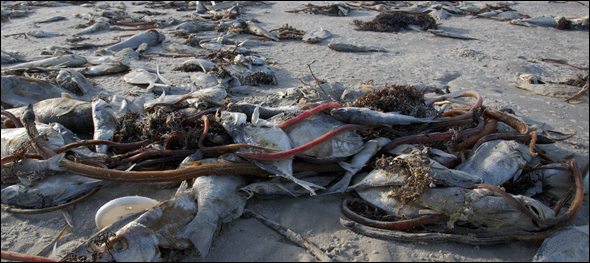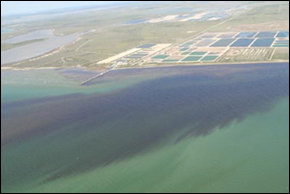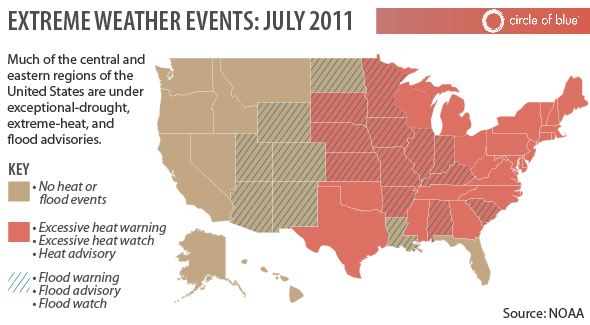Red Tide Downstream of Texas Drought: Marine Ecosystems Suffer Lack of Fresh Water
High temperatures and salinity concentrations along the Texas Gulf Coast are behind a toxic red tide, fish kills, and an influx of oyster parasites. Additionally, several saltwater species have been found upstream, surviving in a typically freshwater environment and signaling a large change in these delta ecosystems.

Marine populations in bay systems along the Texas Gulf Coast are suffering from environments that are saltier — and more toxic — after months of high temperatures and little rain have dried many rivers and streams. The result is dead fish, an unhealthy ecosystem, and a poor shellfish business.
This year’s bloom of toxic Karenia brevis algae — which is unique to the Gulf of Mexico, producing its iconic red tide — began in mid-September, according to the Houston Chronicle. The algae is always present, but populations typically increase during the fall season, after summer has increased water temperatures, salinity concentrations, and nutrient levels.
This year’s bloom comes on the heels of the Texas drought, which started last fall, and is the driest spell in the state’s recorded history. Furthermore, Texas had the warmest summer for any state in the U.S. in recorded history, according to the National Weather Services.
This year’s red tide is the largest in more than a decade, stretching from South Padre Island to Galveston and taking advantage of the warm water that is, in places, twice its normal salinity due to little fresh water flowing into the Gulf. The bloom is unlikely to disperse until more rain lowers salt concentrations, the seasonal shift brings colder temperatures, and stronger currents mix the Gulf’s makeup.
The algae are problematic, because they produce a toxin that paralyzes and kills fish, as well as an airborne toxin that irritates human respiratory systems, the Houston Chronicle reported. As of October 31, the Texas Parks and Wildlife Department estimated that the red tide had killed 4.2 million fish. The department noted, that “while significant, this number is a far cry from the 22 million fish killed during the 1986 red tide.” Additionally, coyotes along the Padre Island National Seashore have been found sick or dead, possibly from ingesting infected fish that were killed and then washed up on shore.

Shellfish, however, are immune to the toxin and can eat the algae. This poses an issue for shellfish harvesters, however, because humans who eat shellfish that have consumed toxic algae can become severely ill, according to Texas A&M University.
Bad for Business
Commercial and recreational shellfish harvesting is currently banned in all Texas coastal waters, despite shellfish season opening earlier this week on November 1. Officials do not know when the waters will reopen, Christine Mann, a spokesperson at the Texas Department of State Health Services, told Circle of Blue. “It will depend on how long it takes the oysters to detoxify,” she said. “We are still seeing increasing algae along the Texas coast. The toxin settles to the ocean floor where it is taken up by the oysters’ tissues, and it takes a while for them to detoxify and become safe to eat.”
Waters are closed to shellfish harvesting when there are at least 5 algae cells per 1 milliliter of water, Mann said. Current algae levels are around 1,000 cells per mL. Harvesting can only resume once the red tide algae is no longer detected in the water and the shellfish test negative for toxins.
Oysters themselves are not harmed by the red tide, but the high salinity levels have invited two salt-loving parasites — the oyster drill mollusk that eats oysters and the dermo protozoa that infects oyster blood — into typically low-salt oyster territory.
Oyster parasites are not the only creatures to move into new waters. The Texas Parks and Wildlife Department is finding species in coastal bays that are typically found in the deeper ocean, and, again, salinity concentrations that are higher than normal for coastal waters are the culprit. Some of the species, such as the cownose ray, are feeding on shellfish like clams and oysters.
Sources: Houston Chronicle; Texas A&M University; Texas Parks and Wildlife Department; Victoria Advocate
A news correspondent for Circle of Blue based out of Hawaii. She writes The Stream, Circle of Blue’s daily digest of international water news trends. Her interests include food security, ecology and the Great Lakes.
Contact Codi Kozacek






Leave a Reply
Want to join the discussion?Feel free to contribute!